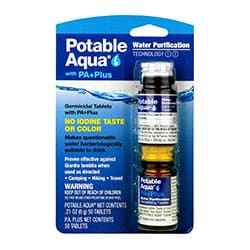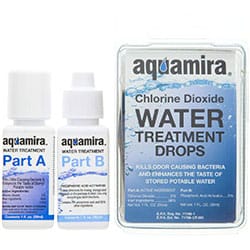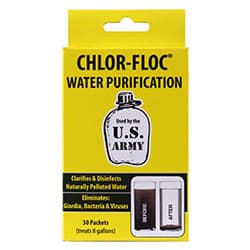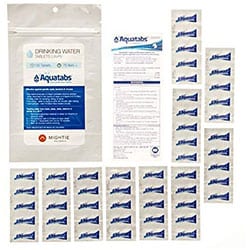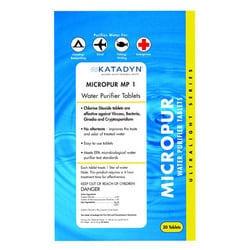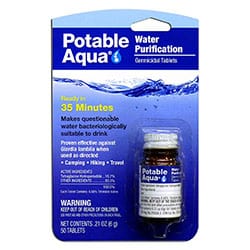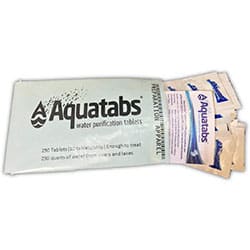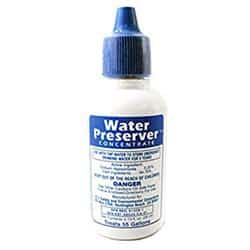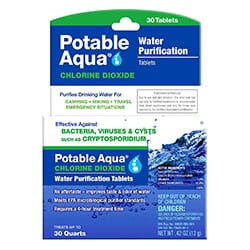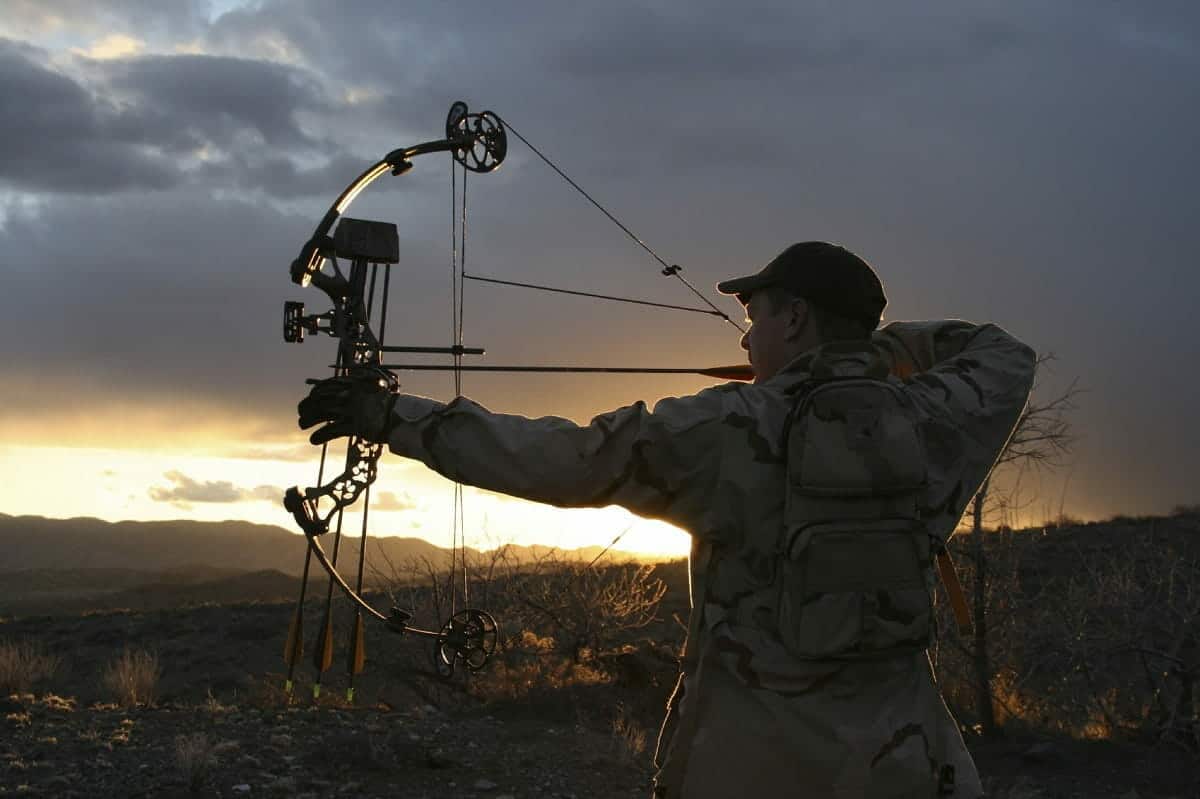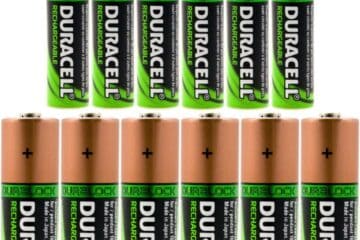Water purification tablets are an easy and convenient way to make sure the drinking water you pull from that mountain stream won’t come back to haunt you. Even the most tranquil and idyllic looking water source can harbor a plethora of microbial nasties intent on wreaking havoc. So it’s important to have some way to ensure they don’t.
Of course, hikers and campers aren’t the only ones who might need to purify water before they drink it. Soldiers, those enduring the aftermath of a natural disaster and those working for NGOs in underdeveloped countries also need to be careful about what goes in their canteen or nalgene bottle. Below, we’ve brought together the 10 best water purification tablets currently available.
1. Potable Aqua PA Plus Water Purification Tablets
Potable Aqua PA Plus tablets use tetraglycine hydroperiodide (1) to neutralize microbial contaminants and make water safe to drink. Tetraglycine hydroperiodide is a form of iodine that provides an effective defense against giardia lamblia and other water-borne bacteria. The company is aware that iodine can leave, what many consider, an offensive aftertaste, so they provide two types of tablets.
The first contains the tetraglycine hydroperiodide to purify the water and the second (the ‘Plus’ of the name) neutralizes the unpleasant aftertaste. The company recommends you use 2 purification tablets for each quart of water and that you match them 1 for 1 with a ‘Plus’ tablet. Works in about half an hour. Very effective. If there’s a downside here it’s that they come in a bottle. Once that bottle is opened the shelf life is reduced to a year or less.
2. Aquamira Chlorine Dioxide Water Treatment Drops
Chlorine dioxide is considered by many to be the most effective agent for purifying iffy water. It does a good job against the major pathogens giardia lamblia and cryptosporidium. Like Potable Aqua, Aquamarine takes a two tiered approach. But their second tier is not intended to address taste.
Instead the first part addresses the pathogens and the second contains phosphoric acid (2) that fends off the growth of mold in your water bottle. Instructions say to place 7 drops from each bottle into an ounce or so of water. When that water turns entirely yellow (which usually takes about 5 minutes) you add it to a liter of water you want to drink and let it sit for 15 minutes. If you are concerned the local water is more contaminated than most simply double the dosage. It won’t hurt you. The company states the product has a 4 year shelf life.
3. Rothco Chlor-Floc
There is some confusion about whether the Rothco Chlor-Floc water purification system takes tablet or powder form. To be absolutely clear you’re provided 30 packets of chlorine powder, not tablets. Each packet of powder is able to purify 1 quart of water. They do an effective job neutralizing the threat of giardia and some other, lower-level bacterial contaminants.
But the real selling point here is how fast they work. Whereas most chlorine tablets take at least half an hour, and chlorine dioxide typically takes 4 hours, these will work in 15 minutes. The 30 packages provided here will purify 8 gallons of water. If there’s a downside it’s that the shelf life is around 6 months. Even though the packets are sealed.
4. Aquatabs Water Purification Tablets
Each Aquatabs water purification tablet contains sodium dichloroisocyanurate (NaDCC). When it comes into contact with water NaDCC releases hypochlorous acid, otherwise known as chlorine. These easy to use tablets are standard fare for WHO field workers, soldiers and others who toil in areas where potable water is in short supply. 2 tablets are sufficient to purify 1 quart of water.
In total you get enough tablets to purify 20 gallons (75 liters) of contaminated water. Just drop the appropriate number of tablets into your water bottle, shake and let sit for 30 minutes. Aquatabs are individually sealed and have a shelf life of 5 years. While Aquatabs are widely known and used their downside is the fairly strong chlorine taste. Some will mind, some will not.
5. Katadyn Micropur MP1 Purification Tablets
Katadyn Mircropur MP1 tablets use chlorine dioxide to purify contaminated water. Thought by many to be the most thorough method of purifying water chlorine dioxide provides effective protection against both giardia and cryptosporidium. Each tablet here is designed to treat 1 liter of water.
The marketing claims that, in some circumstances, it works in 30 minutes. But chlorine dioxide typically takes 4 hours, and that’s how long we’d recommend waiting. Besides being effective at neutralizing the worst waterborne contaminants chlorine dioxide has the added benefit of leaving no nasty aftertaste.
6. Potable Aqua Water Purification Tablets
Potable Aqua makes a number of water purification products. We already took a look at their PA Plus tablets above. These Anti Germicidal water tablets are identical to those you’ll find in the PA Plus system. But what you won’t find here are the secondary ‘Plus’ tablets intended to make the water taste better. The tetraglycine hydroperiodide used here is a form of iodine, with a reputation for leaving a less than pleasant aftertaste.
Those who can’t stand that aftertaste should choose the PA Plus tablets. Those who aren’t bothered by the taste of iodine will find all they need here. Simply plop one tablet into a liter of water and wait a few minutes for it to dissolve. Then shake the bottle to distribute the iodine and let the water sit for 30 minutes before drinking.
7. Aquatabs Deluxe 250-Count
These are the same formula as the Aquatabs we profiled above. The difference is that you get 250 tablets instead of 100. This is good for large groups heading into the wild, or large families who want to be prepared for the worst.
The 250 tablets are enough to purify up to 500 quarts of water using sodium dichloroisocyanurate (NaDCC), which releases chlorine when mixed with water. If you’re an aid worker headed to a remote or storm ravaged area you should consider taking these with you just to be prepared for any eventuality.
8. 55 Gallon Water Preserver Concentrate
Hikers and those in conflict zones aren’t the only ones who need to be concerned about having clean water to drink. If you live in an area that’s prone to hurricanes, flooding or other types of natural disaster you should always have a stash of clean water set aside in case you need it.
In those cases it’s important the water not become fouled while waiting to be used, which can sometimes happen. To keep your emergency water clean and safe to drink use this Water Preserver Concentrate. There’s no magic here so take the ‘proprietary formula’ marketing nonsense with a grain of salt. The product uses a form of bleach to prevent bacterial growth in stored water. But it works.
9. Potable Aqua Chlorine Dioxide Water Purification Tablets
Potable Aqua makes one last appearance on our list with their Chlorine Dioxide Water Purification Tablets. As we’ve mentioned chlorine dioxide is considered to provide the highest degree of protection from the widest variety of bacterial and parasitic contaminants including giardia and cryptosporidium.
The downside is that you’ll need to wait 4 hours before drinking the water. So fill up your bottles and add some of these tablets before going to sleep. When you wake up you’ll have plenty of safe water to use however you want.
10. Lifestraw Water Filtration System
For some people, water purification tablets are a non-starter. If you’re one of those folks consider the Lifestraw Water Filtration System. The Lifestraw is incredibly easy to use. Just remove the caps from each end, stick the bottom end into your drinking water and suck the water through the upper end, just as you would a straw.
The filter in the Lifestraw removes 99% of waterborne bacteria and parasites. It surpasses EPA water filter standards, is affordable and will filter 1,000 gallons of water.
FAQs
Who Needs Water Purification Tablets?
Mountain streams often seem idyllic. But animals don’t have the same aesthetic sense as humans. They tend to relieve themselves wherever and whenever the notion strikes them. Even if that’s at the edge of one of those idyllic mountain streams. Come to think of it, there are plenty of people who do the same thing without thinking. Animals also have a nasty habit of dying in water or in proximity to water. And that can lead to all kinds of microbes entering your Nalgene bottle when you dip it into the stream. Here’s a more comprehensive list of those who should use water purification tablets.
- Hikers/campers – As we just mentioned animals (some humans included) don’t really think about where they relieve themselves. That means you could very well be directly downstream from someone who squatted at the river’s edge a hundred yards upstream from your campsite. While a lot of backpackers/campers bring mechanical filters with them these add to weight. And if you are on a prolonged hiking excursion you want to keep weight down as much as possible. So tablets are a good choice.
- Victims of natural disasters – All too often municipal water supplies become contaminated during floods, hurricanes (3) or earthquakes. When that happens you need some way to ensure the water you’re drinking is safe. If you have an emergency water storage container you’re all set. But if you don’t then it’s a good idea to have some water purification tablets in the house at all times just to be safe.
- Military personnel – Troops deployed overseas often find themselves in conflict zones where basic public services have been compromised or are non-existent. They can’t always bring enough water with them to satisfy their needs so they need a way to purify the water they encounter before drinking it. Water purification tablets are a good way to ensure they don’t succumb to water-borne microbes.
- People working with NGOs – Charitable workers often find themselves in conflict zones rubbing elbows with the military (4). They need clean water to drink just like the soldiers do. Well funded organizations sometimes provide staff with plenty of bottled water. Other times workers are dropped in the middle of nowhere and basically have to fend for themselves. Water purification tablets then become a necessity.
Do All Water Purification Tablets Work the Same Way?
No. There are three kinds of water purification tablets on the market today. Those that use iodine to purify the water, those that use chlorine and those that use chlorine dioxide. More on these 3 in a few moments.
What are Some Common Bacteria That Affect Hikers?
As we mentioned there are a number of situations that call for water purification tablets. But exactly what are these tablets protecting you from?
- Giardia lamblia – This is perhaps the most common type of parasitic infection to befall hikers/campers. It’s found in feces and the infection stems from people and animals depositing feces close to water sources. The resulting parasitic infection is sometimes referred to as ‘beaver fever’ because beavers often carry the parasite and tend to relieve themselves in rivers and streams. Sometimes a healthy adult can survive infection without medical intervention. But in most cases the infected person will need an antibiotic (5) to clear the parasite.
- Cryptosporidium – Cryptosporidium is another microorganism that enters the system through water contaminated with feces. If a person is in possession of a robust immune system they may be able to wait out a cryptosporidium infection. If their immune system is compromised in any way, however, the infection could become serious and require medical intervention. Typically Zithromax (6) or something similar is prescribed for this type of infection.
- Cholera – You hear about the threat of cholera outbreaks often in areas hard hit by natural disasters. The cholera bacteria is found in contaminated water and cholera infection can often be deadly (7). Even for those who seem otherwise healthy. Cholera interrupts the body’s normal intestinal operation leading to watery diarrhea and severe dehydration.
- E. coli – Escherichia coli, or e. coli for short, is a bacteria commonly found in the intestines of animals and people. Depending on the strain of e. coli it can pass in a few days or be extremely serious with abdominal cramps, organ damage and bloody diarrhea. While this bacteria is most often transmitted via food production (restaurant cooks not washing their hands after going to the bathroom) it can also befall hikers and campers by way of infected animals relieving themselves in or near streams.
How Long do Water Purification Tablets Last?
As long as the package has not been opened a water purification tablet will last about 5 years. But keep in mind that once you open the package that life expectancy takes a significant hit. While it’s impossible to estimate exactly how much of a hit it’s safe to assume that any tablets exposed to the air will lose their effectiveness in a few months. This is one reason why so many people prefer to buy tablets that are individually sealed, rather than buying one big bottle of loose tablets.
What are the Main Types of Water Purification Tablets?
Now let’s go back and take a closer look at those 3 types of water purification tablets.
- Chlorine – Chlorine is familiar to anyone who owns a swimming pool or who is aware of how their city or town disinfects its tap water. Billions of people around the world drink water that’s had chlorine added to it at some point and mankind is generally better off for it. Chlorine is effective at killing the giardia lamblia (8) parasite, as well as many less odious types of bacteria. Although it’s not considered the best way to prevent cryptosporidium (9) infection.
- Iodine – Iodine has long been known as an effective agent for purifying water. Like chlorine it is generally effective against giardia lamblia and other less destructive bacteria. There are plenty of people, however, who object to the smell and taste of iodine. This is one potential reason for its generally declining use in recent years. Like chlorine, iodine is considered only an adequate defense against cryptosporidium.
- Chlorine dioxide – Chlorine dioxide is considered by many to be the most effective water purification agent. It will provide protection against everything that regular chlorine and iodine will, plus it’s considered the best defense against cryptosporidium. So why aren’t all water purification tablets chlorine dioxide-based? Because it takes 4 hours to work. Whereas regular chlorine and iodine tablets each take about 30 minutes. A lot of people just don’t want to wait so long.
How do Water Purification Tablets Work?
Chemically, the different types of water purification tablets work in different ways. And there simply isn’t room here to go into a detailed analysis of the chemical mechanisms of each. In the broadest, general sense, however, the process for using a tablet like this is as follows:
- Fill your container from the available water source
- Drop the appropriate number of tablets into the container (see exact amounts on the package)
- Put the cap on a little loose so that air can escape
- After a few minutes shake the bottle lightly (hold that loose cap) to mix up the dissolved tablet
- Let the water sit anywhere from 30 minutes to 4 hours (depending on the type of tablet used)
Always defer to the specific instructions on the actual product.
Are There Other Ways to Purify Water?
Not everyone wants to use water purification tablets. Some don’t want to spend the money, others don’t want the chemical taste that they can bring and some just don’t like the idea of adding anything to their drinking water. For these folks there are options. Those options are:
- Boiling water – This method has been used for thousands of years (10). Even before people understood what it was in the water that was sometimes making them sick they nonetheless realized that if they boiled water before drinking it that they wouldn’t get sick. Today, boiling water remains just as viable and effective a way of purifying water as it was during the days of ancient Egypt. If you arrive at your campsite to discover you forgot your water purification tablets you can just spark up the stove and boil your water before drinking it. It’s also a pretty fast method of purifying water, since you only have to keep it boiling vigorously for a minute or two. The downside is that you have to wait for the water to cool down to drink it. And you’ll be burning up precious stove fuel.
- Water filters – The typical water purification filter passes water through a cartridge that removes bacteria and other microbial life from the water. While today’s commercially available water filters for camping and such are not able to remove some contaminants, they’ll often be sufficient to protect you from the major microbial players. Filters for home use are typically more involved and may use certain chemicals as well as UV light that kills off a wider array of nasty microbes (11). The downside of filters, especially for hiking and camping, is that they add weight to, and take up space in your pack.
The Bottom Line
Water purification tablets are a smart choice for anyone planning to spend time in an area where safe tap water may not be available. In this day and age, it is never a bad idea to be prepared and have these on hand. They’re light, effective, affordable and can prevent you being besieged by very nasty parasites like giardia lamblia and cryptosporidium. Any of the above water purification products should protect you from the wrath of environmental microbes. They’ll ensure you have a safe patrol or camping experience, or that you’re able to survive in the aftermath of a natural disaster.
